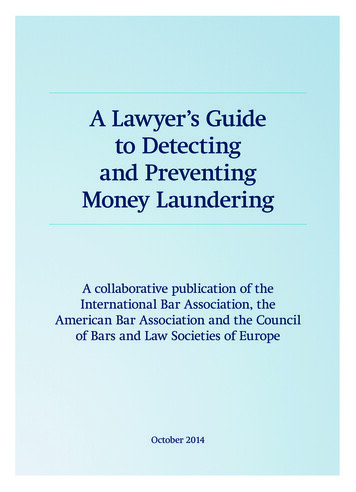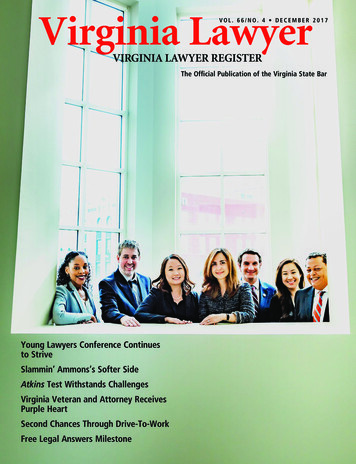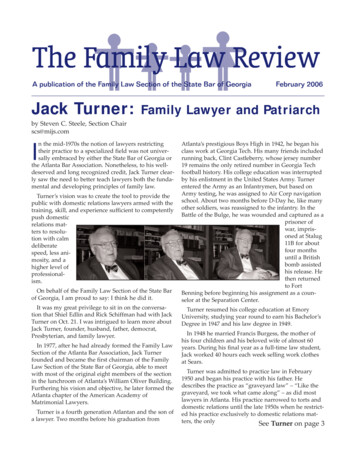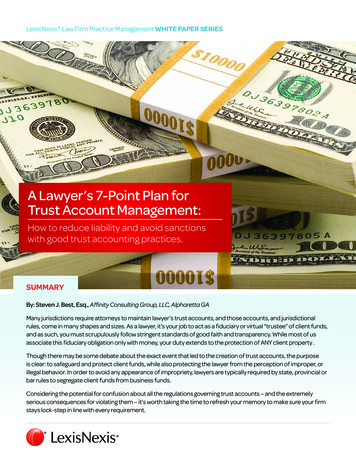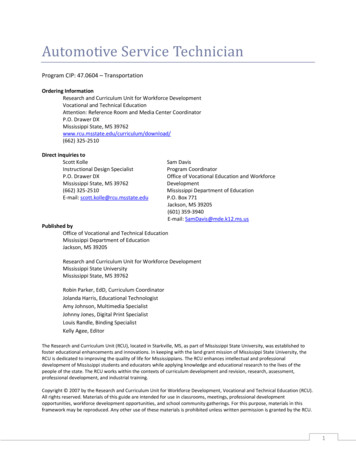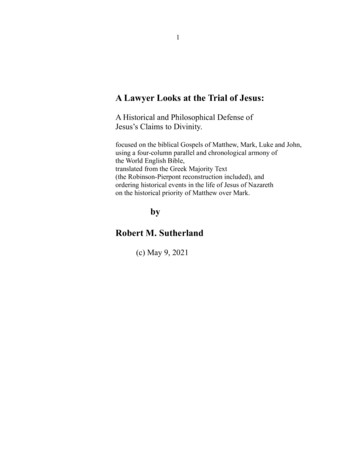
Transcription
1A Lawyer Looks at the Trial of Jesus:A Historical and Philosophical Defense ofJesus’s Claims to Divinity.focused on the biblical Gospels of Matthew, Mark, Luke and John,using a four-column parallel and chronological armony ofthe World English Bible,translated from the Greek Majority Text(the Robinson-Pierpont reconstruction included), andordering historical events in the life of Jesus of Nazarethon the historical priority of Matthew over Mark.byRobert M. Sutherland(c) May 9, 2021
2“World English Bible” (WEB), 2005, un-copyrighted. Used with thanks. All scripturalquotations in this work are from the World English Bible, unless otherwise statedThe Robinson-Pierpont reconstruction of the “Majority Text”, also known as the “ByzantineText”, 2005, un-copyrighted. Used with thanks. All Greek scriptural quotations in this workare from the Robinson-Pierpont reconstruction of the Majority Text, unless otherwise stated. Copyright 2021 Robert M. Sutherland. All rights reserved.This publication, in whole or part, MAY be reproduced, stored in a retrieval system, ortransmitted, in any form or by any means, electronic, mechanical, photocopying, recording,or otherwise, without the written prior permission of the author, but with an acknowledgmentof this author’s authorship of whatever material is used.I seek no royalities.If a book publisher wishes to reduce this work to a hard copy form for others, they can chargesuch profit for their work as they deem appropriate for their work. They just need to know inadvance that all other publishers have that same right. And the PDF and Word formattedcopies of this book remain available free of charge to all on the internet.The Word formatting has the unique ability when downloaded to allow the student reader tosave one copy and make a second copy of their personal development. They can they insertinto that second copy commentary between the various formatted sections, or rearrange thosesections, or substitute their preferred biblical translation for the WEB text.Freely I received, freely I give.NOTE: BECAUSE THIS BOOK IS BEING PRESENTED AS IT IS BEING WRITTENAND TWEAKED, THE READER SHOULD CHECK THIS WEBSITE FOR THE LATESTVERSION OF THE WORK WHICH WILL BE INDICATED BY THE DATE ON THEFRONT PAGE.
3This book is dedicated to my wifeCindy Sutherland.
4TABLE OF CONTENTSINTRODUCTION1. The basic question to be asked and answered0142. This book’s author0163. This book’s use of the World English Bible0184. This book’s use of the Greek Majority Text0185. This book’s use of the Priority of Matthew over Mark0256. Helpful methodologies for the reader0307. A proper methodology for understanding truth0308. A proper methodology for understanding the natural moral law0399. A proper methodology for understanding historical inquiry04310. An improper methodology for understanding historical inquiry06511. A proper methodology for understanding the Trinitarian-Unitarian controversy 077A CHRONOLOGICAL PRESENTATION OF THE GOSPEL EVIDENCE1. Authorial introductions(Matthew 1:1; Mark 1:1; Luke 1:1-4; John 1:1-18)1872. Jesus’ genealogy(Matthew 1:2-17; Luke 3:23-38)1913. The angel’s revelation to Zechariah and his response(Luke 1:5-25)1954. The angel’s revelation to Mary and her response(Luke 1:26-56)1965. The angel’s revelation to Joseph and his response(Matthew 1:18-25)1986. The birth of John the Baptist and Zechariah’s response(Luke 1:57-80)199
57. Caesar’s census and the birth of Jesus(Luke 2:1-7)2018. The angel’s revelation to the Bethlehem shepherds and their discovery of Jesus(Luke 2:8-20)2019. Jesus’ circumcision in the Temple and Simeon’s and Anna’s discovery of Jesus(Luke 2:21-39)20310. Wise men journey from the east and their discovery of Jesus(Matthew 2:1-12)20411. Joseph, Mary and Jesus flee into Egypt and return(Matthew 2:13-23)20612. Jesus’ early life in Nazareth(Luke 2:39-40)20713. Jesus’ trip to Jerusalem at age 12(Luke 2:41-51)20714. Jesus’ early life in Nazareth continued(Luke 2:52)20815. John the Baptist baptizes Jesus(Matthew 3:1-17; Mark 1:2-11; Luke 3:1-22; John 1:6-14,19-34)20916. Jesus meets his future disciples: Andrew, John, Philip, Nathanael(John 1:35-51)22517. Jesus and friends go to a wedding in Cana(John 2:1-11)22718. Jesus goes to Capernaum with family and friends(John 2:12)22819. Jesus is tempted by the devil in the wilderness(Matthew 4:1-11; Mark 1:12-13; Luke 4:1-13)22820. Jesus cleanses the Temple for the first time(John 2:13-25)23121. Jesus meets with Nicodemus the Pharisee that night(John 2:23-3:21)23722. Jesus instructs his disciples and they baptize(John 3:22-36)239
623. John is arrested and Jesus leave for Galilee(Mt 4:12; Mk 1:14; Lk 4:14; Jn 4:1-3)24024. Jesus meets the Samaritan woman at the well(John 4:4-42)24125. Jesus arrives in Galilee(Matthew 4:12-17; Mark 1:14-15; Luke 4:14-15; John 4:43-45)24426. Jesus heals a royal official’s son(John 4:46-54)24727. Jesus calls Simon, Andrew, James and John a second time(Matthew 4:18-22; Mark 1:16-20; Luke 5:1-11)24728. Jesus delivers a Capernaum sermon(Mark 1:21-28; Luke 4:31-37)25029. Jesus delivers the Sermon on the Mount(Mathew 4:23-7:29)25230. Jesus heals a leper(Matthew 8:1-4; Mark 1:40-45; Luke 5:12-16)25931. Jesus heals a centurion’s servant(Matthew 8:5-13; Luke 7:1-10)26132. Jesus raises the son of the widow of Nain from the dead(Luke 7:11-17)26333. Jesus heals Peter’s mother-in-law and others(Matthew 8:14-17; Mark 1:29-34; Luke 4:38-44)26434. Jesus crosses the Sea of Galilee, and calms the Sea(Matthew 8:18-27; Mark 4:35-41; Luke 8:22-26)26635. Jesus heals two Gergesene/Gadarene demoniacs and their response(Matthew 8:28-9:1; Mark 5:1-20; Luke 8:26-39)26936. Jesus heals a paralyzed man on a bed and forgives sin(Matthew 9:1-8; Mark 2:1-12; Luke 5:17-26)27437. Jesus meets his future disciple Matthew and dines with sinners(Matthew 9:9-17; Mark 2:13-22; Luke 5:27-39)27638. Jesus heals a hemorrhaging woman and raises Jairus’s daughter from the dead
7(Matthew 9:18-26; Mark 5:22-43; Luke 8:40-56)27639. Jesus heals two blind men(Matthew 9:27-31)28540. Jesus heals a mute demoniac(Matthew 9:32-34)28541. Jesus does a Galilean tour(Matthew 9:35-38)28642. Jesus chooses 12 disciples for a Jewish ministry(Mt 10:1-42; Mk 3:13-19; 6:6-13; Luke 6:12-16; 8:1-3; 9:1-6)28643. Jesus delivers the Sermon on the Plain(Luke 6:17-49)30244. John the Baptist, through disciples, questions Jesus about his ministry(Matthew 11:1-30; Luke 7:18-35)30545. Jesus dines at the house of Simon the Pharisee(Luke 7:36-50)30946. Jesus’ disciples pluck grain on the Sabbath(Matthew 12:1-8; Mark 2:23-28; Luke 6:1-5)31147. Jesus heals a man with a withered hand on the Sabbath(Matthew 12:9-21; Mark 3:1-12; Luke 6:6-11)31348. Jesus heals a blind mute demoniac(Matthew 12:22-50; Mark 3:19-35)31649. Jesus delivers a series of parables on the kingdom of heaven(Matthew 13:1-53; Mark 4:1-34; Luke 8:4-21)32150. Jesus heals and invalid at the pool of Bethesda on the Sabbath(John 5:1-47)33151. Jesus delivers a sermon in Nazareth(Matthew 13:54-58; Mark 6:1-6; Luke 4:16-30)33852. Herod Antipas's interest in Jesus as John the Baptist returned from the dead(Matthew 14:1-12; Mark 6:14-29; Luke 9:7-9)34253. Jesus feeds 5000 and the crowds attempt to make him king(Matthew 14:13-23; Mark 6:30-44; Luke 9:10-17; John 6:1-15)346
854. Jesus crosses the Sea of Galilee by walking on water(Mt 14:24-33; Mk 6:45-52; Jn 6:16-21)35355. Jesus heals the sick in Gennesaret(Matthew 14:34-36; Mark 6:53-56)35756. Jesus delivers the Bread of Life sermon in Capernaum(John 6:22-7:1)35857. Jesus declares the oral and oral ceremonial law obsolete(Matthew 15:1-20; Mark 7:1-23)36158. Jesus heals the demoniac child of a Syrophoenician woman(Matthew 15:21-28; Mark 7:24-30)36559. Jesus heals the mute, deaf, lame and blind in Decapolis(Matthew 15:29-31; Mark 7:31-37)36660. Jesus feeds 4000(Matthew 15:32-38; Mark 8:1-9)36861.Jesus talks about the sign of Jonah and the leaven of the Pharisees(Matthew 15:39-16:12; Mark 8:10-21; John 7:1)36962. Jesus heals a blind man(Mark 8:22-26)37263. Peter confesses Jesus to be the Messiah(Matthew 16:13-20; Mark 8:27-30: Luke 9:18-21)37364. Jesus predicts his death in Jerusalem for the first time(Matthew 16:21-28: Mark 8:30-9:1: Luke 9:22-27)37565. Jesus is transfigured(Matthew 17:1-13; Mark 9:2-13; Lk 9:28-36)37866. Jesus heals an epileptic demoniac child(Matthew 17:14-21; Mark 9:14-29; Luke 9:37-43)38167. Jesus predicts his death in Jerusalem for a second time(Matthew 17:21-23; Mark 9:30-32; Luke 9:43-45)38568. Jesus pays the temple tax(Matthew 17:24-27)38669. The disciples’ dispute over who is the greatest in the kingdom of heaven(Matthew 18:1-22; Mark 9:33-50; Luke 9:46-50)387
970. Jesus contemplates going to Jerusalem for Tabernacles, leaves Galilee(John 7:1-13)39871. Jesus at the Feast of Tabernacles: the political controversy(John 7:14-36)39972. Jesus at the Feast of Tabernacles: the water controversy(John 7:37-58)40073. Jesus at the Feast of Tabernacles: the woman caught in adultery(John 7:59-8:11)40274. Jesus at the Feast of Tabernacles: the light of the world controversy(John 8:12-59)40375. Jesus at the Feast of Tabernacles: the man born blind controversy(John 9:1-10:6)40676. Jesus goes to Jerusalem for the Feast of Dedication(John 10:7-42)41177. Jesus begins his final journey to Jerusalem(Matthew 19:1; Mark 10:1; Luke 9:51-52)41378. Jesus in Samaria and reprimands James and John, the sons of thunder(Luke 9:51-62)41379. Jesus picks 70 disciples for a Samaritan ministry(Luke 10:1-24)41480. Jesus and the parable of the Good Samaritan(Luke 10:25-37)41681. Jesus visits with Mary and Martha(Luke 10:38-42)41782. Jesus teaches on the power of prayer(Luke 11:1-13)41883. Jesus exorcises a demoniac and is challenged(Luke 11:14-36)41984. Jesus dines with a Pharisee(Luke 11:37-54)42185. Jesus teaches about blasphemy against the Holy Spirit
10(Luke 12:1-12)42286. Jesus delivers a series of parables(Luke 12:13-13:9)42387. Jesus heals a crippled woman on the Sabbath(Luke 13:10-17)42788. Jesus delivers a further series of parables(Luke 13:18-21)42889. Jesus speaks of the narrow gate to heaven(Luke 13:22-30)42890. Jesus is warned about Herod Antipas and laments over Jerusalem(Luke 13:31-35)42991. Jesus a man with dropsy on the Sabbath(Luke 14:1-6)42992. Jesus delivers a further series of parables(Luke 14:7-17:10)43093. Jesus heals 10 lepers(Luke 17:11-19)43794. Jesus speaks of the coming of the Son of Man(Luke 17:20-37)43895. Jesus delivers a further series of parables(Luke 18:1-14)43996. Jesus speaks on marriage, divorce, celibacy and blesses children(Matthew 19:3-15; Mark 10:2-16; Luke 18:15-17)44097. Jesus encounters a rich ruler(Matthew 19:16-30; Mark 10:17-31; Luke 18:18-30)44498. Jesus delivers the parable of labourers in the vineyard(Matthew 20:1-16)44999. Jesus raises Lazarus from the dead(John 11:1-57)443100. Jesus predicts his death in Jerusalem a third time(Matthew 20:17-19; Mark 10:32-34; Luke 18:31-34)454
11101. James and John vie for positions in the kingdom of heaven(Matthew 20:20-28; Mark 10:35-45)455102. Jesus heals a blind man Bartimaus(Matthew 20:29-34; Mark 10:46-52; Luke 18:35-43)457103. Jesus meets a future disciple Zacchaeus(Luke 19:1-10)459104. Jesus delivers the parable of the 10 servants(Luke 19:11-28)460105. Jesus is anointed the first time(John 12:1-11)461106. Jesus enters Jerusalem triumphantly(Mt 21:1-11; Mk 11:1-11; Lk 19:29-44; Jn 12:12-19)462107. Greeks come to Jesus through Philip(John 12:20-50)471108. Jesus cleanses the temple a second time(Matthew 21:12-27; Mark 11:12-19; Luke 19:45-48)473109. Jesus delivers the parable of the fig tree(Matthew 21:18-22; Mark 11:12-14, 20-26)476110. Jesus comments on his authority and relationship to John the Baptist(Matthew 21:23-27; Mk 11:27-33; Lk 20:1-8)477111. Jesus delivers the parable of the 2 sons(Matthew 21:28-32)479112. Jesus delivers the parable of the vineyard(Matthew 21:33-46; Mark 12:1-12; Luke 20:9-19)480113. Jesus delivers the parable of the banquet(Matthew 22:1-14)484114. Jesus comments on the payment of taxes to Caesar(Matthew 22:15-22; Mark 12:13-17; Luke 20:20-26)485115. Jesus comments on the afterlife(Matthew 22:23-33; Mark 12:18-27; Luke 20:27-40)487116. Jesus comments on the greatest commandment(Matthew 22:34-40; Mark 12:28-34)490
12117. Jesus comments on David’s son and David’s lord(Matthew 22:41:46; Mark 12:35-37; Luke 20:41-44)491118. Jesus condemns the Pharisees(Matthew 23:1-39; Mark 12:38-40; Luke 20:45-47)496119. Jesus comments on the widow’s mite(Mark 12:41-44; Luke 21:1-4)501120. Jesus delivers the Olivet discourse to his disciples(Matthew 24:1-25:46; Mark 13:1-37; Luke 21:5-38)502121. Jesus's opponents finalize their plot to kill(Matthew 26:1-5,14-16; Mark 14:1-2,10-11; Luke 22:1-6)523122. Jesus is anointed a second time(Matthew 26:6-13; Mark 14:3-9)525123. Jesus celebrates the Last Supper(Matthew 26:17-35; Mark 14:12-31; Luke 22:7-38; John 13:1-17:26)529124. Jesus is arrested in the Garden of Gethsemene(Matthew 26:36-56; Mark 14:32-52; Luke 22:39-53; John 18:1-12)583125. Jesus' Jewish trial before Caiaphas(Matthew 26:57-27:2; Mark 14:53-15:1; Luke 22:54-71; John 18:13-26)594126. Judas commits suicide(Mt 27:3-10)607127. Jesus' Roman trial before Pilate(Matthew 27:11-31; Mark 15:1-20; Luke 23:1-25; John 18:28-19:18)608128. Jesus is executed by crucifixion(Matthew 27:31-56; Mark 15:21-41; Luke 23:26-49; John 19:18-30)629129. Jesus is buried(Matthew 27:57-66; Mark 15:42-47; Luke 23:50-56; John 19:31-42)645130. Various women, Peter, John at the empty tomb and Jesus appears(Mt 28:1-15; Mk 16:9-11; Luke 24:1-12; John 20:1-18)653131. Jesus appears to 2 disciples on the road to Emmaus(Mark 16:12-13; Luke 24:13-35)666132. Jesus appears to the disciples in Jerusalem absent Thomas
13(Mark 16:14-18; Luke 24:33-49; John 20:19-23)670133. Jesus appears to the disciples in Jerusalem with Thomas(John 20:24-30)674134. Jesus appears to the disciples in Galilee(John 21:1-25)675135. Jesus appears and delivers the great commission(Matthew 28:16-20; Mk 16:15-18)678136. Jesus appears and ascends to heaven(Mark 16:19-20; Luke 24:50-53; Acts 1:1-12)678HISTORICAL CONCLUSIONS DRAWN FROM THE GOSPEL EVIDENCE1. The nature, logic and language of historical inquiry6832. Issue 1- The claims to divinity6843. Issue 2- An execution for those claims to divinity6854. Issue 3- A resurrection establishing those claims to divinity686A PHILOSOPHICAL CHECK ON THAT HISTORICAL EVIDENCE1. The nature, logic and language of metaphysical inquiry6872. Issue 1-The existence of God6883. Issue 2- The existence of Trinity6894. Issue 3- The existence of the Incarnation6905. Issue 4- The existence of the Final Judgement6916. Issue 5- The existence of Heaven and Hell692CONCLUSION: EXAMINATION AND INVITATION693A BIBLIOGRAPHY694
14INTRODUCTION1. THE BASIC QUESTION TO BE ASKED AND ANSWEREDThe biblical gospels of Matthew, Mark, Luke and John tell the greatest story ever told.(1) The second divine person of the triune God of love came to earth in the person of Jesus ofNazareth to demonstrate the height, breadth and depth of the love of God, and to offer and effect apersonal transformation in and through that love, in this life and the next life, for all who wouldtrust in and and surrender to him.Is that basic assertion true? I find it is. And the proof of its truth is the subject matter of this book.The biblical gospels of Matthew, Mark, Luke and John explicitly assert three things:(2) Jesus of Nazareth claimed to be divine.(3) He died for that claim.(4) He rose again from the dead to establish the truth of that claim.These are purely historical matters, knowable and provable, through human reason, on a balanceof probabilities, in the court of public opinion.Are these three historical assertions true? I find they are. And the proof of their truth is the subjectmatter of this book. But that is not the end of the story or this book. Any historical proof requiresfurther philosophical proof. Why? The answer is simple. History is in the realm of the possible:what is said to have happened in the past. Philosophy sets out the range of the possible, what canhappen: past, present or future. While philosophy can be a handmaiden to theology, it is equallytrue that philosophy is, or at least can be, a traffic cop to history.The biblical gospels of Matthew, Mark, Luke and John implicitly assert five further things:(5) the existence of God,(6) the existence of the Trinity,(7) the existence of the Incarnation,(8) the existence of the Resurrection, and(9) the existence of a Final Judgement.These are purely philosophical matters, knowable and provable, through human reason, either withdemonstable certainty or with probable inference from such demonstrable certainties, in the courtof public opinion.Are these five philosophical assertions true? I find they are. And the proof of their truth is thesubject matter of this book. It is a matter of no small importance. If any of these five things arelogically impossible and knowable as such, then any historical claim that Jesus rose from the deadin fulfillment of a truth claim to be divine is necessarily false, regardless of how good the historical
15evidence is in its favour. I find that philosophy presents no such insurmountable obstacles to thehistorical evidence and, in fact, provides valuable corroborative support for that historical evidence.Consequently, the ultimate answer to the most basic question is yes: “the second divineperson of the triune God of love came to earth in the person of Jesus of Nazareth to demonstratethe height, breadth, and depth of the love of God, and to offer and effect a personal transformationin and through that love, in this life and the next life, for all who would trust in and surrender tohim” for the historical and philosophical evidence establishs the truth of that claim.There is one important caveat to this book. Knowledge is but a pre-amble to faith. Theknowledge afforded by any proper historical and philosophical inquiry certainly commends itselfto the mind for acceptance as truth, at least until such time as further evidence or better ways ofweighing the evidence become available.But knowledge is not faith. It is said in the scriptures themselves that the devils themselvesknow the historical and philosophical truth of thse things, but remain damned. Why? Because theyhave not taken the second step from knowledge to faith.(1) Knowledge is an intellectual act.(2) Faith is a certain type of volitional act, a personal and passionate choice and committment,sometimes based on knowledge, sometimes not.As a relational concept, faith is always expressed as the oneness of three things: gratitudefor, surrender to, and love of a particular person. The gospel writers of Matthew, Mark, Luke andJohn present the knowledge of Jesus of Nazareth that they do, for the purpose of enjoining theirreaders to make a personal and passionate committment to him.(1) They enjoin a faith in Jesus that is a personal gratitude to Jesus for what he has done for you,especially on the cross, and will do for you personally, especially in this life and at the time of theFinal Judgement.(2) They enjoin a faith in Jesus that is a personal surrender to Jesus as your rightful lord and saviourhere in this life.(3) They enjoin a faith in Jesus that is an on-going personal transformation by the love of God inand through Jesus actually living in you.Faith is different from knowledge, as any act of the will is different from any act of theintellect. But faith is related to the knowledge of the truth. A faith in Jesus is only a saving faith, iftwo things are historically and philosophically true.(1) Jesus is who he claimed to be: God incarnate, and(2) Jesus can and will do what he claimed he will do: grant eternal salvation to all who trust in himand only him.
16In that respect, the knowledge provided in this book may be helpful for readers, eitherprompting a personal choice in faith to invite Jesus into their lives or reinforcing a choice alreadymade. And that choice is beyond the scope of this book. The reader can only make it for themselves.2. THIS BOOK’S AUTHORI suspect the reader will want to know who I am.First, I am a Canadian defense lawyer with 35 years at the bar. I hold a four-year HonoursB.A. in the History of Ideas from University of Toronto (1977-1981). I hold a three-year L.L.B. inLaw from Osgoode Hall Law School (1981-1984).My law school criminal law and criminal procedure professor was Louise Arbour, who would laterbecome a Supreme Court of Canada justice, sit on the World Court in the Hague and is currentlythe United Nations Human Rights commissioner.I have practised criminal law, child protection law and family law for 35 years in five provinces:Ontario (1986-2005), Alberta (2005-2007), Newfoundland-Labrador (2007-2010), Nova Scotia(2010-2017), Manitoba (2017-2018), Nova Scotia (2018-2021).In the course of my career, I have some notable successes, changing the law nationally andprovincially at various points in time. Throughout my career, my legal work has been focused onthe representation of the poor and those otherwise in dire need of help.Second, I am a philosophically moderate realist and a natural law thinker, in the traditionof the three great Western thinkers: Aristotle, Thomas Aquinas and Mortimer J. Adler.The last of the three was one of my mentors. Mortimer J. Adler was a prominent 20th centuryAmerican philosopher of common sense, a former law school professor from the University ofChicago, the head of the Institute for Philosophical Research, and for many decades the Chairmanof the Board of Editors of the Encyclopedia Britannica, responsible for its publication of the 62volume Great Books series.I first discovered his writings in 1988, was quickly transformed by them, joining his AmericanChicago-based think-tank The Mortimer J. Adler Center for the Study of the Great Ideas(http://www.thegreatideas.org), serving as its Canadian director for a number of years, and havingcommunications with Dr. Adler through its director Max Weismann.I would strongly recommend to my readers fourteen of Dr. Mortimer J. Adler’s books:How to Read a Book (1972),How to Think About the Great Ideas (2000)Six Great Ideas: Truth, Goodness, Beauty, Justice, Liberty, Equality (1981),Ten Philosophical Mistakes (1985),The Difference of Man and the Difference It Makes (1967)We Hold These Truths: Understanding the Ideas and Ideals of the Constitution (1987),
17A Vision of the Future: Twelve Great Ideas for a Better Life and a Better Society (1984)Haves without Have-Nots: Essays for the 21st Century of Democracy and Socialism (1991)How to Think About War and Peace (1944)Intellect: Mind over Matther (1990)Desires Right and Wrong: The Ethics of Enough (1991)The Angels and Us (1982)Truth in Religion: The Plurality of Religions and the Unity of Truth (1990), andHow to Think About God: A Guide for the Twentieth Century Pagan (1980)And I would equally strongly recommend to my readers four of Dr. Edward Feser’s books:Aquinas: A Beginner’s Guide (2009),Philosophy of Mind: A Beginner’s Guide (2006),Scholastic Metaphysics: A Contemporary Introduction (2014),Five Proofs of the Existence of God (2017),These eighteen books should form the core of any thinking person’s library, and certainly areessential reading for any college, university or post-graduate work in any discipline.Third, I am an evangelical Christian, theologically traditional in most areas, but distinctlyBaptist in my rejection of the doctrine of original sin and its inherited transmission of damnation.I was not raised Christian and had no childhood religious upbringing. In my high school years(1972-1977), I read virtually all the writings of an English Calvinist poet John Milton (1608-1674),a Scottish Presbyterian theologian William Barclay (1907-1978), a German philosopher FriedrichNietzsche (1844-1900), and an Austrian pyscho-analyst Eric Fromm (1900-1980), and thosereadings were formative in bringing about my ultimate religious conversion.I trace my spiritual journey back to a powerful “born-again” experience on August 20, 1976. I wasaged 18 years old at the time, alone in a tent in middle of the backwoods of Prince Edward Island.I had just finished listening to a Christian sharing his testimony with others around a campfireoutside my tent. He was not reaching them, but he was reaching me. He never knew it, and henever knew I was there. I have always regarded it as a profound reminder that you never know theinfluence you can have on others.In 1981, I was simultaneously accepted into the “Wycliffe” Anglican seminary at the TorontoSchool of Theology and the Osgoode Law School. I choose the law school over the seminary. Andit was not a choice I have ever regretted.My legal training and career have afforded me the time, training and treasure to pursue my religiousinterests in the direction and depth that I wanted. In 2004, I published a book Putting God on Trial:The Biblical Book of Job, a revolutionary contribution to Job studies that has been a course text inseveral Canadian, American and Indian universities.Over the years, I have been blessed with many blessings. The most important blessing is my closest
18friend and selfless wife Cindy Sutherland, whom I cherish beyond life itself. My hope, my prayeris that the reader would find such a companion as she on their journey.In the meantime, I can recommend a number of my spiritual companions for my readers.One is Dr. Malcolm Guite. His “You-Tube” videos on Love, Light, Coleridge, Lewis and Tolkienare real blessings.Another is Dr. Eleanore Stump. Her audiobook Aquinas: the Universal Teacher is unsurpassed inits profundity and practicality. There is no better introduction to Christian life of love and to thehighest moral virtue of magnanimity.Finally, there is Dr. Charles Mathewes. His two audiobooks City of God and Why Evil Exists arereal treasures. The latter audiobook Why Evil Exists is perhaps the greatest book ever written inthe 21st century. It’s an even-handed, engaging, and enlightening “grand tour” of the very best inWestern secular and religious thinking on subject of good and evil from 4000 BC to the present.What’s in the mind of the wrongdoer at the moment they chose to do evil? Why is defining andcomprehending evil, explaining its nature and origin, such a perennial and difficult problem for usas human beings? And how might we best fight evil in ourselves and our societies? Everyone,everywhere, should wrestle with the questions that book raises and with the range of options itoffers. The experience will be transfiguring.I currently fellowship in and am a member at my local church down the street, a part of the UnitedChurch of Canada.3. THIS BOOK’S USE OF THE WORLD ENGLISH BIBLEI have used the World English Bible (WEB) for this work, integrating some of its notes inbrackets into the text, for two reasons.First, I would note the World English Bible (WEB) is a modern translation in the King JamesVersion (KJV) tradition: elegant, readable and fairly literal. It is actually an evangelical revisionof the 1901 American Standard Version (ASV), which itself was a kind of KJV update. I havechosen it over the KJV or ASV, because the language is more modern. No translation can ever beor should be completely literal, for simple reason that it would cease to be a translation. And yet,there are real advantages in aiming, as this translation does, at a formal rather than a dynamicequivalence in the translation of Hebrew or Greek into English. The reader does not have to believein the inerrancy of the scriptures in order to read the texts closely, attentive to what is actually said.Second, I would note that the World English Bible (WEB) has the decisive advantage ofbeing free from all copyright and attendant royalties. Virtually all modern English translations arecopyrighted. If I were to use any popular modern translation, then my reproducing all four gospelsin parallel columns for analysis would be virtually impossible financially. The owner of thecopyright to those modern translations would normally require an up-front royalty of at least 10,000 and on-going royalties of at least 10 for each individual sale. I choose to make this workaffordable and available to all free of charge.
194. THIS BOOK’S USE OF THE GREEK MAJORITY TEXTI note that the World English Bible (WEB) is translated from the Greek Majority Text (MT),which some might think a problem, but I do not.First, all New Testament (NT) translations necessarily build on some particularreconstructed Greek text.(1) The original autographs do not survive.(2) Out of the 5865 ancient manuscripts or fragments of the Greek NT that do survive, no twodocuments agree 100% with each other. The printing press would not be invented until 1454 AD.(3) For the approximate 138,000-142,000 Greek New Testament words, depending on thereconstructed Greek text chosen for the NT, there are about 500,000 variant readings, though theydo seem to divide into families of textual variants, where a family is defined as its members sharing,at least 60% of the time, common textual readings for a passage.(4) A textual variant or textual reading is any place in the text where there is a difference in languagefrom a base text. You might call it an error or a corruption, but you need not. It is just a difference.Those differences can be simple differences in spelling (as there was no standardized ancientspelling of a word), in word order (as there was no standardized ancient grammar and there werevarious ways to convey a single thought with no loss in meaning), or in additions or omissions ofwords (sometimes accidental, sometimes intentional). This is what generates the high number of500,000 textual variants.(5) What is important is not the number of textual variants, but their nature or kind. About 99.5%are not meaningful or viable. They do
This publication, in whole or part, MAY be reproduced, stored in a retrieval system, or transmitted, in any form or by any means, electronic, mechanical, photocopying, recording, or otherwise, without the written prior permission of the author, but with an acknowledgment

